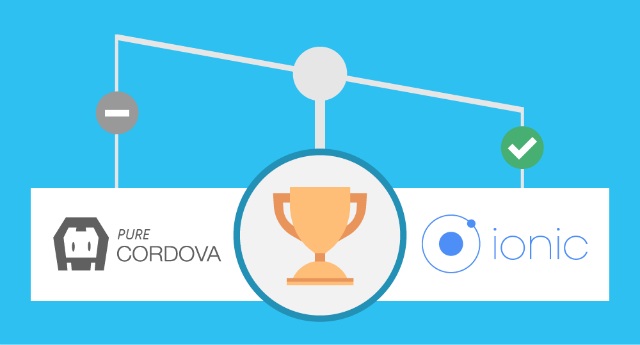Ionic vs. Pure Cordova: Three Reasons Ionic Wins
Saying that one particular type of mobile development (native, cross-platform or hybrid) is the only right way to create mobile apps is similar to saying that only one programming language is the most suitable for coding. As project requirements are always unique, while tools and technologies have different qualities and, what’s more, constantly evolving, nothing can be just black and white.
That’s why, even knowing that hybrid development has a large scope for improvement, we at ScienceSoft keep an eye on its progress and are delighted to see what the Ionic framework can offer developers today.
What’s Ionic?
Used for hybrid development in HTML, CSS, and JavaScript, Ionic allows to quickly create powerful and beautifully designed mobile apps that can be deployed through Cordova. Ionic is built on top of AngularJS and, apart from helping you build a solid app structure with it, uses Angular directives for all its components. As a result, component implementation gets simplified to several lines in HTML.
How Does Ionic improve Cordova Development?
Ionic wraps all Cordova commands and lets you work with any Cordova plugin or additional package. Along with it, you have the following three advantages over Cordova-only development.
#1: Slick UI and UX
Ionic is a perfect fit for the easy and fast development of a simple but trendy design with everything you may need already included in the framework kit. At your disposal, there are dozens of templates, over 80 mixins, 700+ standard icons and lots of built-in UI elements such as headers, footer bars, buttons, grid elements and more. This is definitely a better start than the empty app screen you see in Cordova.
You also get all the UI components: lists, navigation, action sheet, pop over, “pull to refresh” as well as other features that you can implement in your app by writing two or three lines of code. What’s more, the code commands are relatively simple and can be easily recognized by developers. You definitely would know what “ion-infinite-scroll” or “ion-refresher” is.
But in case you stumble upon something unclear, Ionic is ready to help you out with its official documentation and active support community.
A More Convenient Development Process
The ‘serve’ feature is present in both Ionic and Cordova and allows developers to access an HTTP-server to test the application code in a desktop browser. However, working with ‘cordova-serve’ is rather inconvenient as it doesn’t let you launch the test from your initial www-folder and forces you to create an app build first.
Things are different with ‘ion-serve’. You can edit your code in the app folder and immediately see it altered since the app prototype tab is refreshed automatically after every single change. A similar effect can be achieved with Grunt in Cordova, but unlike the out-of-the-box Ionic feature, it’s far from being perfect.
Higher Performance of the Final Product
Compared to Cordova-built apps, the Ionic code creates more powerful and higher performing applications. With jqLite, a fraction of jQuery, it takes a minimal DOM manipulation, and native hardware acceleration is enough. Ionic optimizes animation effects and tunes up the GPU work to achieve the best processing time. Hence, those milliseconds of tap delay that are present in all hybrid apps (due to the bridged gap between the app and the native SDK) are cut in half, and the application gets to perform more vigorously.
Conclusion
Ionic may be referred to as a mere Cordova wrapper, but it actually brings hybrid development to the next level. Besides being a useful tool for creating a beautiful design, it also eases the development process and powers up the application’s performance. If you want to know more about app development on Ionic, feel free to contact ScienceSoft’s mobile application developers.
About the Author
Vadzim Belski is Head of Web Development Department at ScienceSoft, a software development and consulting company headquartered in McKinney, Texas. With over 13 years of experience, he has been taking part in web projects with a primary focus on large-scale IT engagements, such as Viber (an instant messaging and VoIP app with 700 mln active users), Globus VPN Browser and others.
(dpe)
